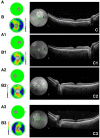Correlation between Retinal Vascularization and Disease Aggressiveness in Amyotrophic Lateral Sclerosis
- PMID: 36289652
- PMCID: PMC9598742
- DOI: 10.3390/biomedicines10102390
Correlation between Retinal Vascularization and Disease Aggressiveness in Amyotrophic Lateral Sclerosis
Abstract
Abnormalities in retinal vascularization and neural density have been found in many neurodegenerative diseases; however, conflicting results are described in Amyotrophic Lateral Sclerosis (ALS). The aim of the present study was, therefore, to systematically analyze retinal layers and vascularization by means of spectral-domain (SD-OCT) and optical coherence tomography angiography (OCT-A) in ALS patients. We enrolled 48 ALS patients and 45 healthy controls. ALS patients were divided into three groups: slow progressors (n = 10), intermediate progressors (n = 24) and fast progressors (n = 14), according to the disease progression rate. For SD-OCT, we evaluated the Subfoveal choroidal thickness (SFCT), ganglion cell complex (GCC) and retinal nerve fiber layer (RNFL). Regarding the OCT-A, we assessed the vessel density (VD) in superficial and deep capillary plexuses, radial peripapillary capillary plexus, choriocapillary and the foveal avascular zone (FAZ) area. SD-OCT exam did not show any significant differences in GCC and RNFL thickness between patients and controls and among the three ALS groups. The SFCT was statistically greater in patients compared with controls (357.95 ± 55.15 µm vs. 301.3 ± 55.80 µm, p < 0.001); interestingly, the SFCT was thicker in patients with slow and intermediate disease progression than in those with fast disease progression (394.45 ± 53.73 µm vs. 393.09 ± 42.17 µm vs. 267.71 ± 56.24 µm, p < 0.001). OCT-A did not reveal any significant results. Amyotrophic Lateral Sclerosis Functional Rating Scale-Revised (ALSFRS-r) and disease duration did not correlate with any of the OCT parameters, except for SFCT with ALSFRS-r (r = 0.753, p = 0.024). This study demonstrated the possible association between choroidal thickness and disease activity in ALS. OCT could be a useful biomarker in the management of the disease.
Keywords: ALS; OCT; angiography; biomarker; choroid; disease progression; eye; inflammation; retinal nerve fiber layer; vascular.
Conflict of interest statement
The authors declare no conflict of interest. The funders had no role in the design of the study, in the collection, analyses or interpretation of data, in the writing of the manuscript or in the decision to publish the results.
Figures


Similar articles
-
Evaluating the Quantitative Foveal Avascular Zone and Retino-Choroidal Vessel Density Using Optical Coherence Tomography Angiography in a Healthy Indian Population.Cureus. 2022 Aug 4;14(8):e27669. doi: 10.7759/cureus.27669. eCollection 2022 Aug. Cureus. 2022. PMID: 36072178 Free PMC article.
-
Retinal nerve fiber layer thinning found in amyotrophic lateral sclerosis - Correlation with disease duration and severity.Indian J Ophthalmol. 2023 Feb;71(2):369-378. doi: 10.4103/ijo.IJO_1870_22. Indian J Ophthalmol. 2023. PMID: 36727322 Free PMC article.
-
Retinal thinning in amyotrophic lateral sclerosis patients without ophthalmic disease.PLoS One. 2017 Sep 25;12(9):e0185242. doi: 10.1371/journal.pone.0185242. eCollection 2017. PLoS One. 2017. PMID: 28945811 Free PMC article.
-
Retinal Vascular Abnormalities and Clinical Parameters in Systemic Sclerosis.J Clin Med. 2024 May 7;13(10):2738. doi: 10.3390/jcm13102738. J Clin Med. 2024. PMID: 38792282 Free PMC article.
-
Retinal changes in amyotrophic lateral sclerosis: looking at the disease through a new window.J Neurol. 2021 Jun;268(6):2083-2089. doi: 10.1007/s00415-019-09654-w. Epub 2019 Dec 2. J Neurol. 2021. PMID: 31792674 Review.
Cited by
-
Retinal structure and vessel density changes in cerebral small vessel disease.Front Neurosci. 2024 Feb 26;18:1288380. doi: 10.3389/fnins.2024.1288380. eCollection 2024. Front Neurosci. 2024. PMID: 38469574 Free PMC article.
-
Exploring amyotrophic lateral sclerosis through the visual system: A systematic review.Eur J Neurol. 2024 Dec;31(12):e16475. doi: 10.1111/ene.16475. Epub 2024 Sep 20. Eur J Neurol. 2024. PMID: 39302063 Free PMC article.
-
Deep Learning and Machine Learning Algorithms for Retinal Image Analysis in Neurodegenerative Disease: Systematic Review of Datasets and Models.Transl Vis Sci Technol. 2024 Feb 1;13(2):16. doi: 10.1167/tvst.13.2.16. Transl Vis Sci Technol. 2024. PMID: 38381447 Free PMC article.
-
Longitudinal Changes in the Retinal Nerve Fiber Layer Thickness in Amyotrophic Lateral Sclerosis and Parkinson's Disease.J Clin Neurol. 2024 May;20(3):285-292. doi: 10.3988/jcn.2023.0353. Epub 2024 Apr 2. J Clin Neurol. 2024. PMID: 38627230 Free PMC article.
-
Optical Coherence Tomography Angiography: Revolutionizing Clinical Diagnostics and Treatment in Central Nervous System Disease.Aging Dis. 2024 Jan 20;16(1):77-114. doi: 10.14336/AD.2024.0112. Online ahead of print. Aging Dis. 2024. PMID: 38300645 Free PMC article. Review.
References
Grants and funding
LinkOut - more resources
Full Text Sources
Miscellaneous

